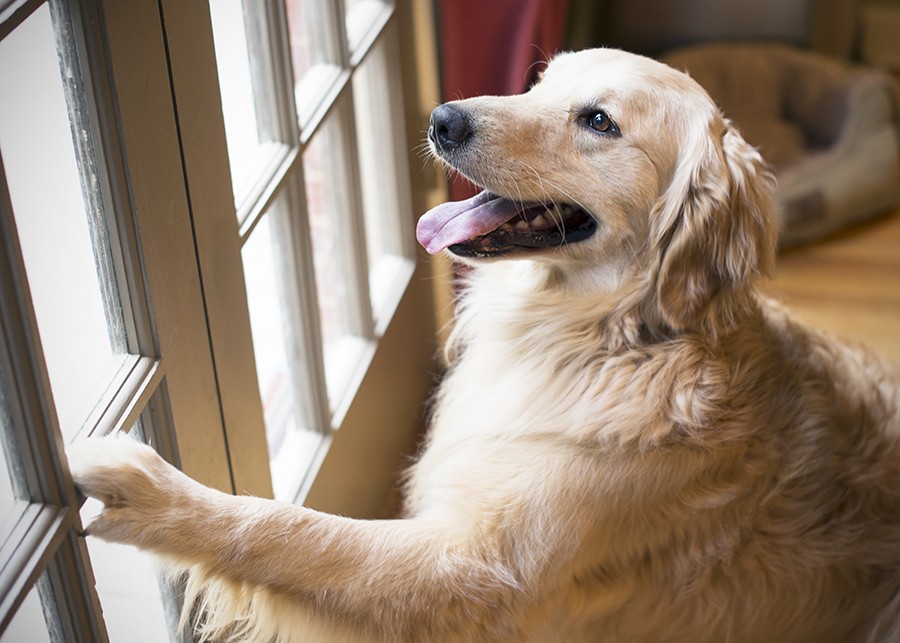
Door Issues
The door is the epicenter of some common nuisance behaviors in dogs, particularly door dashing and unwanted barking. With positive training and a little patience, these are both behaviors that can be improved and potentially eliminated.
Door Dashing
Door dashing is a very common behavior that can have obvious dangerous consequences. The first step in stopping this behavior is to find out why your dog wants to run away in the first place.
Why Do Dogs Door Dash?
- Many dogs become bored in their home environment and are stimulated by the opportunity and excitement they feel when they make their escape.
- Dogs that don’t get a lot of opportunity to go outside may door-dash to get a taste of freedom, while others with high prey drive and a deep-rooted instinct to run and chase are driven by their desire to hunt.
- Most domestic dogs live in a sensory deprived environment, so the promise of fun and excitement outside the home is too much for them to ignore – escaping makes them feel good.
How to Stop Your Dog From Door-Dashing
- Start by teaching valuable impulse control. Dogs are born with little self-control and it is up to us to teach them ‘manners’ so they can live more successfully in a domestic environment.
- Teach your dog to ‘stay‘ by putting your hand up and holding it still until you give the signal that it is ok to move, followed by a food or toy reward for complying.
- Once you have your dog’s focus, gradually lengthen the time that your hand is still until your dog can stay in place for a minute.
- Ask him to stay and take a step back. If he breaks his stay, lure him back to his original waiting place and repeat the exercise.
- Repeat until you can walk about ten feet away from him without him following you. You are now ready to move to the door.
- Repeat the exercise by the front door with your dog staying a good distance away from the door.
- Put your hand on the door and rattle the door handle. This is a physical and auditory cue that the door is about to be opened, which might trigger your dog to move towards the door. Lure your dog back to his place until you can rattle the door handle without him moving.
- For each exercise, go back and treat him for staying in one place. This means you are continually reinforcing him for staying still.
- If your dog is complying, then you can move onto the next level. Open the door a tiny crack, shut it again and go back to your dog to reinforce the stay with a treat. Continue until you have the door wide open with your dog staying still.
- During this training process your dog will be problem solving – working out what he has to do to get a reward.
 So much traditional training is centered on thinking for the dog that people forget how vital it is to allow the dog to think for himself with your guidance. Problem solving is extremely important and provides valuable mental stimulation that motivates and keeps the dog’s mind active and fit.
So much traditional training is centered on thinking for the dog that people forget how vital it is to allow the dog to think for himself with your guidance. Problem solving is extremely important and provides valuable mental stimulation that motivates and keeps the dog’s mind active and fit.
- The next stage is to add triggers that signal someone is at the door and a door dashing opportunity is imminent. Ring the doorbell yourself or having a family member outside do it for you. It is one thing for your dog to sit and wait by a door during a calm training session, but quite another to use self-control after the doorbell has rung.
- Be patient because your dog is likely to react to the trigger of the bell. Calmly lead him back to his place and repeat until he no longer moves when he hears the bell. Open the door to reveal that no one is outside.
- Repeat the exercise with family members coming through the door, guests and then strangers, as long as your dog is sociable and safe around new people.
- This teaching exercise might take time. Don’t rush it and be patient, because you will see success. Remember that every dog is unique and learns at a different pace.
Barking at the Doorbell
Another common problem between dogs and the door is excessive barking, particularly when the doorbell rings. The formula for solving this problem is similar to the protocol above for door dashing.
The key is to desensitize your dog to the sound of the doorbell:
- Sit somewhere near your front door and ask a friend or neighbor to ring the doorbell. When it rings, completely ignore the doorbell as well as your dog’s barking. Do not stand up, speak, or open the door.
- Wait till your dog is completely silent before getting up to open the door.
- Allow your dog to greet your guest as his reward.
- Repeat this process until your dog becomes desensitized to the sound of the doorbell. This may take multiple 10-15 minute sessions.
- Be patient! Some dogs learn more quickly than others.





